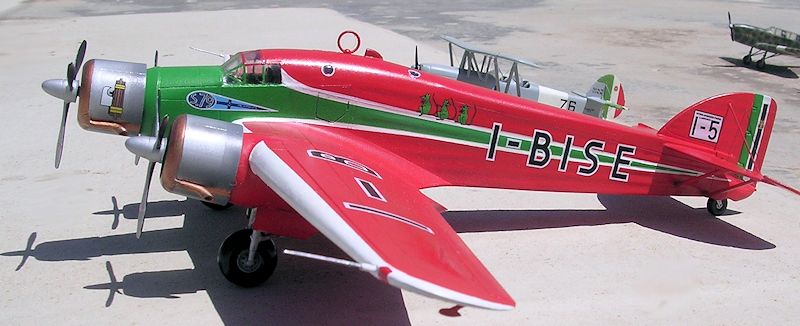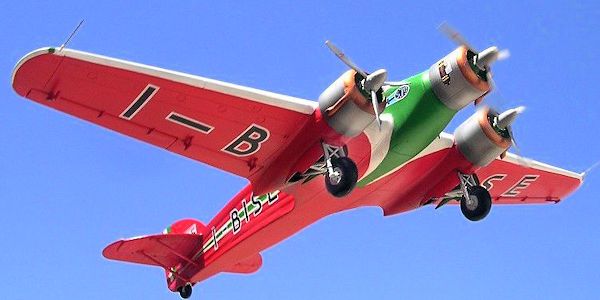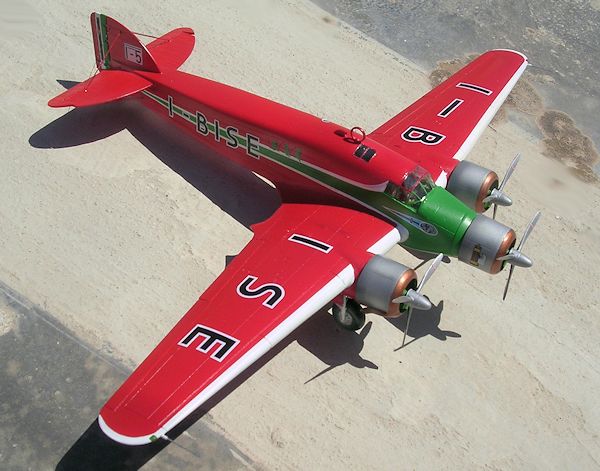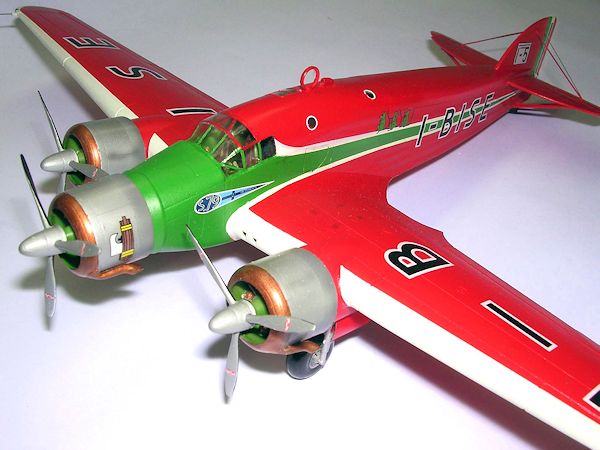
Italeri 1/72 S.79T Conversion
| KIT #: | 1243 |
| PRICE: | $ |
| DECALS: | Two options |
| REVIEWER: | Carmel J. Attard |
| NOTES: | Pavla Conversion set used |

| HISTORY |
The tri-motor S-79T was a long-range version
of the S-79C with increased fuel capacity and Alfa Romeo 126 KC34 engines. Three
S-79Cs were converted to S-79Ts, the T standing for Trans Atlantic. These were
prepared for a South Atlantic crossing on route where scheduled airline service
was being planned.
The identity of the three S-79Ts was as
follows: MM359 I-BIMU became I-BISE, after pilot Attilio Biseo and Amadeo
Paradisi MM358 I-CUDA became I-MONI and MM356 I-FILU became I-BRUN indicating
each airplane commander. After detailed preparation, the three S-79Ts took off
on January 1938 for record flight to Rio Di
 Janeiro, Brazil, via Dakar, Senegal,
which was the route of many previous pioneering ocean flights.
Janeiro, Brazil, via Dakar, Senegal,
which was the route of many previous pioneering ocean flights.
The ‘Green Mice’ S-79T I-BISE, formerly I-5
I-BIMU had markings that are mixed with civil registration and I for Italy on
the rudder and also the military shield on the white rudder stripe.
The three ‘Green Mice’ flew almost 10,000
Kilometres at an average speed of 248 mph, landing in Rio on the evening of 25th
January with one S-79 being slowed down by propeller trouble. The flight was
possibly the final act of the Golden Age of aviation prior to the outbreak of
the Second World War. The last pioneering flight was further emphasised in the
Italian media because of the presence of Bruno Mussolini. The 19-year-old Bruno
was the Italian dictator Benito Mussolini’s son who later died in 1941
testing a
Piaggio
P-108 bomber.
The three aircraft were later presented to the
Brazil air service which serialled them K420, 421 and 422. In 1938 a standard
S-79 bomber that was sent to Brazil to stimulate an order for Italian warplanes
that did not materialize also joined them. The aircraft had limited activity due
to lack of spares and support. They were struck off Brazilian charge in 1943/44.
| THE KIT |
 Converting the Italeri S79 III Sparviero
bomber into the S-79T could be carried out in the distant past using the
Superscale decals that provides decals for any one of the three named above, and
the extra work needed to convert the forward half of the fuselage is left for
the modeller to do.
Converting the Italeri S79 III Sparviero
bomber into the S-79T could be carried out in the distant past using the
Superscale decals that provides decals for any one of the three named above, and
the extra work needed to convert the forward half of the fuselage is left for
the modeller to do.
| CONSTRUCTION |
The conversion simply consisted of removing
the cumbersome raised ventral gunner turret and replaces it along with the vac
form fuselage top section. This also replaces the bomber side gunner’s position.
A continuation of the fine fuselage ripples was built up with a little filler
and shaped to form continuous ripple detail at the lower fuselage in place of
the various side windows, which have been blanked. Bracing wires were added to
the tail fin and tail planes at each side.
 one may follow to make the S-79T
one may follow to make the S-79T
| COLORS & MARKINGS |

| CONCLUSIONS |
 I do not mind building a ’between wars’
civilian type from time to time and there is history attached to this aircraft
with the most colourful livery that made it all the more attractive when
complete. I recommend this medium level conversion to anyone interested in the
peaceful years era of aviation history.
I do not mind building a ’between wars’
civilian type from time to time and there is history attached to this aircraft
with the most colourful livery that made it all the more attractive when
complete. I recommend this medium level conversion to anyone interested in the
peaceful years era of aviation history.
March 2013
If you would like your product reviewed fairly and fairly quickly, please contact the editor or see other details in the Note to Contributors.